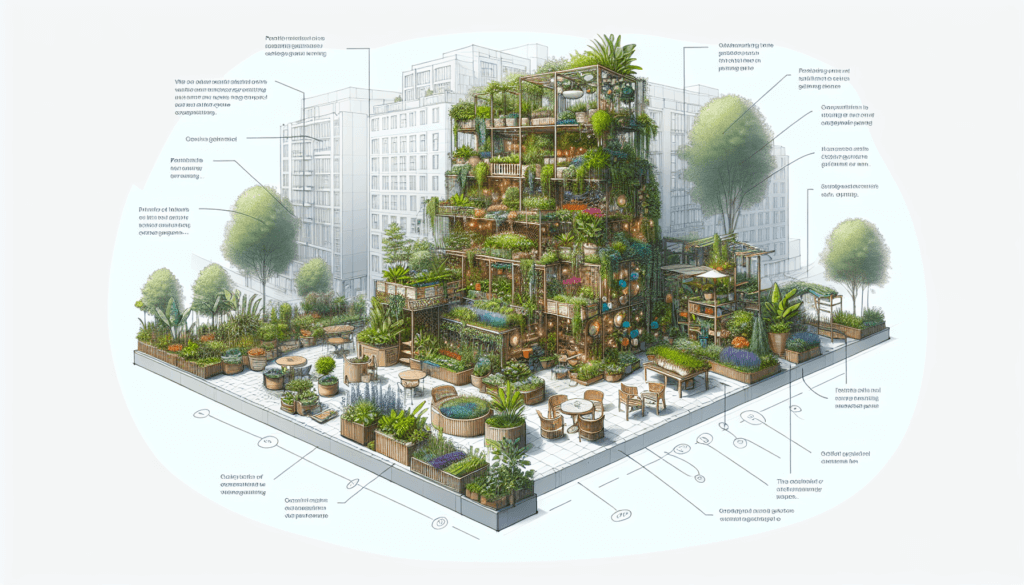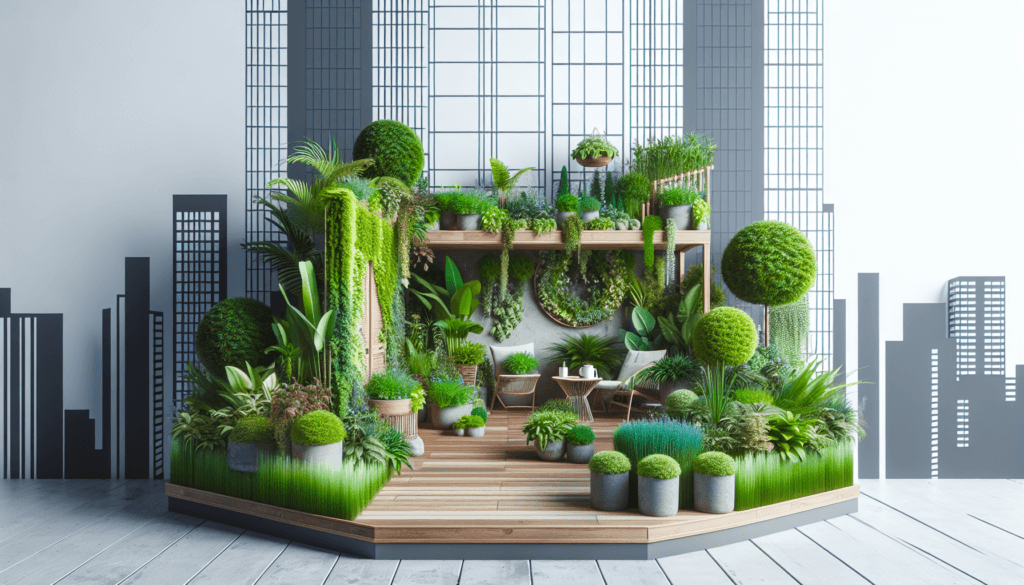Are you ready to transform your urban space into a lush and vibrant garden oasis? Look no further than this Beginner’s Guide to Urban Garden Design, where you’ll discover the secrets to creating a thriving garden in even the tiniest of spaces. From selecting the perfect plants to maximizing sunlight and working with limited square footage, this guide will equip you with all the tools and knowledge you need to create a beautiful and sustainable urban garden. Say goodbye to concrete jungles and hello to your own slice of natural paradise. Let’s get started on your green thumb journey!
Choose the Right Location for Your Urban Garden
Evaluate sunlight exposure
When choosing a location for your urban garden, it is important to evaluate the amount of sunlight the area receives. Most vegetables and flowers require at least 6-8 hours of direct sunlight each day to thrive. Take note of any buildings, trees, or other structures that may cast shadows and block sunlight. Observe the area throughout the day to determine the amount of sunlight it receives and choose a spot that will provide optimal conditions for your plants.
Consider space availability
Another important factor to consider when selecting a location for your urban garden is the available space. Determine how much space you have and choose a spot that can accommodate your gardening needs. If you have limited space, consider vertical gardening techniques or utilizing containers to make the most of your area. On the other hand, if you have a larger space, you may have more room for raised beds or multiple garden zones.
Assess soil quality
Assessing the quality of the soil in your chosen location is crucial for the success of your urban garden. Test the soil’s pH level and nutrient content to ensure it is suitable for plant growth. If the soil is poor, you may need to amend it by adding organic matter such as compost or aged manure. Additionally, consider the drainage of the soil to prevent waterlogging. If the soil is compacted or draining poorly, you may need to create raised beds or improve the soil structure before planting.
Select Suitable Plants for Urban Gardening
Determine your gardening goals
Before choosing which plants to grow in your urban garden, it is important to determine your gardening goals. Are you looking to grow your own vegetables, create a beautiful flower garden, or a combination of both? Identifying your goals will help you select plants that align with your vision for your urban garden.
Consider the climate and weather conditions
When selecting plants for your urban garden, it is essential to consider the climate and weather conditions of your area. Some plants thrive in cooler temperatures, while others prefer warmer climates. Research the specific requirements of the plants you are interested in growing to ensure they are suitable for your location. Take note of the average temperatures, frost dates, and rainfall patterns in your area to choose plants that will flourish in your urban garden.
Choose plants based on available space
The available space in your urban garden will also influence the selection of plants. If you have limited space, consider growing compact or dwarf varieties of vegetables and flowers. These plants are bred to take up less space and are perfect for container gardening or small raised beds. Additionally, choose plants that have a vertical growth habit, such as vine plants or those that can be trellised, to maximize your garden’s space.

Plan Your Garden Layout
Sketch the garden area
Planning your garden layout is an essential step in creating a successful urban garden. Start by sketching the area where you plan to garden. Include any existing structures such as buildings, fences, or pathways. This will help you visualize the space and determine the best placement for your plants and garden features.
Divide the space into zones
To make the most of your urban garden, consider dividing the space into different zones. This allows for better organization and efficient use of the available space. You can have separate zones for different types of plants, such as vegetable beds, flower beds, and herb gardens. Additionally, consider creating a seating or relaxation area where you can enjoy the beauty of your garden.
Decide on the types of beds
When planning your garden layout, consider the types of beds you will use. Raised beds are a popular choice for urban gardens as they provide better drainage and are easier to maintain. They also help define the boundaries of your garden and can add aesthetic appeal. If space is limited, consider using vertical gardening techniques or utilizing containers for your plants.
Implement Vertical Gardening Techniques
Utilize vertical space for plant growth
Vertical gardening is an excellent technique for maximizing space in your urban garden. Instead of relying solely on ground planting, take advantage of vertical structures such as walls, fences, or trellises. Train vine plants to grow vertically, utilize hanging baskets or pockets, or create living walls with a variety of plants. Vertical gardening not only helps save space but also adds visual interest to your urban garden.
Explore different vertical gardening structures
There are various structures you can use for vertical gardening in an urban setting. Trellises, arbors, and frames provide support for climbing plants and can be used to create vertical layers in your garden. Wall-mounted planters or modular systems allow you to grow herbs, flowers, or vegetables on vertical surfaces. Alternatively, consider repurposing items such as pallets or ladders for vertical gardening structures. Get creative and find the structures that suit your gardening style and available space.
Consider hanging plants and trellises
Hanging plants and trellises are great options for urban gardens with limited ground space. Hanging baskets or containers can be hung from hooks, railings, or overhead structures, adding visual interest and utilizing unused vertical space. Trellises provide support for climbing plants and can be attached to walls or mounted in containers. They create a vertical element in your garden and can also act as privacy screens or shade providers.

Utilize Container Gardening
Select suitable containers
Container gardening is a popular technique for urban gardening, as it allows you to grow plants in limited space. When choosing containers for your urban garden, ensure they have good drainage and are appropriate for the size of the plants you intend to grow. Consider using a variety of containers such as pots, troughs, hanging baskets, or even repurposed items like buckets or barrels. Get creative with your container choices and ensure they enhance the aesthetics of your urban garden.
Use the right soil mix
The soil mix you use in your containers plays a crucial role in the success of your urban garden. Choose a high-quality potting mix that is well-draining, lightweight, and nutrient-rich. Avoid using garden soil as it may become compacted in containers, leading to poor drainage. You can also add organic matter such as compost or vermicompost to improve the fertility and moisture-holding capacity of the soil mix.
Implement proper watering techniques
Proper watering is essential for the health and vitality of your container plants. Containers tend to dry out faster than plants in the ground, so monitor the moisture levels regularly. Water your plants when the top inch of soil feels dry to the touch. Ensure that water penetrates the entire root zone and drains out of the bottom of the container. Consider using self-watering containers or installing a drip irrigation system to make watering more efficient.
Consider Companion Planting
Understand companion planting principles
Companion planting is the practice of growing certain plants together to benefit one another. Some plants have natural attributes that repel pests, attract beneficial insects, or enhance soil fertility. Understanding companion planting principles can help improve the health and productivity of your urban garden. For example, planting marigolds alongside tomatoes can deter aphids, while growing basil near peppers can enhance their flavor.
Choose compatible plant combinations
When implementing companion planting in your urban garden, choose plant combinations that are compatible and mutually beneficial. Some classic examples include pairing tomatoes with basil or planting carrots alongside onions. By selecting plant combinations that work well together, you can create a harmonious and thriving garden environment. Research specific compatibility charts or consult gardening resources for more ideas and suggestions.
Promote natural pest control
Companion planting can also help promote natural pest control in your urban garden. Some plants produce chemical compounds or emit odors that repel pests, reducing the need for synthetic pesticides. For example, planting garlic or chives near roses can deter aphids, while attracting beneficial insects like ladybugs or lacewings. By utilizing companion planting, you can create a healthier and more sustainable garden ecosystem.

Implement Sustainable Gardening Practices
Conserve water usage
Conserving water is an important aspect of sustainable urban gardening. Reduce water wastage by implementing practices such as collecting rainwater in barrels or using drip irrigation systems. Use mulch or organic materials to retain moisture in the soil and prevent evaporation. Water your plants in the early morning or late evening to minimize water loss due to evaporation. Finally, choose drought-tolerant or native plants that require less water.
Reduce synthetic chemical inputs
Incorporating sustainable gardening practices involves reducing the use of synthetic chemical inputs. Synthetic fertilizers, pesticides, and herbicides can have adverse effects on the environment and human health. Instead, opt for organic fertilizers such as compost, worm castings, or seaweed extracts to nourish your plants. Implement integrated pest management techniques to control pests naturally, such as using insecticidal soaps or introducing beneficial insects.
Utilize composting and mulching
Composting and mulching are excellent practices for improving soil fertility and reducing waste in your urban garden. Composting allows you to recycle kitchen scraps, yard waste, and other organic materials into nutrient-rich compost. Use the compost to amend your garden soil or as a natural fertilizer for your plants. Mulching helps conserve moisture, suppress weeds, and regulate soil temperature. Use organic mulch such as wood chips, straw, or shredded leaves to benefit your urban garden.
Create a Watering and Irrigation System
Determine watering needs of plants
Different plants have varying watering needs, and it is important to understand the requirements of the plants in your urban garden. Some plants prefer consistently moist soil, while others prefer slightly drier conditions. Research the specific watering needs of the plants you are growing and adjust your irrigation system accordingly. Consider grouping plants with similar watering needs together to optimize watering efficiency.
Choose appropriate irrigation methods
There are various irrigation methods you can choose from to water your urban garden effectively. Options include drip irrigation, soaker hoses, sprinkler systems, or hand watering. Each method has its advantages and considerations. Drip irrigation is water-efficient and helps deliver water directly to the root zone of plants. Soaker hoses provide a slow, deep watering method, while sprinkler systems are more suitable for larger garden areas. Hand watering allows for a personal connection with your plants but can be time-consuming.
Install a timed watering system
Installing a timed watering system is a convenient way to ensure your plants receive adequate moisture without the need for constant monitoring. Timers can be connected to drip irrigation systems, sprinklers, or soaker hoses, allowing you to set specific watering schedules. Consider using a weather-based irrigation controller that adjusts watering based on rainfall and temperature. A timed watering system helps conserve water and provides plants with a consistent water supply, promoting healthy growth.

Maintain and Care for Your Urban Garden
Regularly monitor plants for pests and diseases
Regularly monitoring your plants for pests and diseases is essential to catch any issues early and prevent them from spreading. Inspect the leaves, stems, and flowers of your plants for signs of damage, discoloration, or pests. Examine the undersides of leaves for eggs or larvae. If you notice any problems, take immediate action to address them. Utilize organic pest control methods such as handpicking pests or spraying with insecticidal soap to protect your plants.
Implement proper pruning and trimming techniques
Pruning and trimming are important maintenance tasks for keeping your urban garden in optimal condition. Regularly remove dead or diseased plant material to prevent the spread of diseases. Prune back overgrown or leggy plants to encourage bushier growth. Remove spent flowers to promote continuous blooming. Ensure you use clean, sharp tools and follow proper pruning techniques to prevent damage to your plants.
Provide adequate nutrients and fertilization
Providing your plants with adequate nutrients is crucial for their growth and overall health. Regularly fertilize your urban garden to replenish the nutrients in the soil. Choose fertilizers that are appropriate for the specific needs of your plants, such as balanced organic fertilizers or those formulated for specific plant types, such as flowering plants or vegetables. Follow the recommended application rates and methods to avoid over-fertilization, which can harm your plants.
Harvest and Enjoy the Fruits of Your Labor
Know when to harvest different crops
Knowing when to harvest your crops is key to enjoying the fruits of your labor at their peak flavor and quality. Different crops have different indicators of readiness for harvest. For example, vegetables like tomatoes and peppers should be harvested when they are fully colored and firm. Leafy greens can be harvested at any stage of growth but are best when young and tender. Research the specific harvesting guidelines for each crop in your urban garden to ensure the best harvest results.
Enjoy the rewards of your urban garden
After putting in the effort to plan, plant, and care for your urban garden, it’s time to enjoy the rewards. Take pride in the beautiful flowers, delicious vegetables, or aromatic herbs you have grown. Spend time in your garden, relaxing, and immersing yourself in the beauty of nature. Share your urban garden with friends and family, inviting them to experience the joy and fulfillment that comes from growing your own food and creating a thriving urban oasis.
Consider preserving or sharing excess produce
If your urban garden produces an abundance of fruits, vegetables, or herbs, consider preserving or sharing the excess. Preserve produce by canning, freezing, or drying to enjoy your harvest throughout the year. Share the bounty with neighbors, friends, or local community organizations. Consider participating in food swaps or donating to food banks to reduce food waste and contribute to your community. Sharing your harvest can bring joy to others and foster a sense of connection within your urban gardening community.
In conclusion, creating an urban garden is a rewarding endeavor that allows you to connect with nature, grow your own food, and beautify your surroundings. By choosing the right location, selecting suitable plants, planning your garden layout, utilizing vertical gardening techniques, implementing container gardening, considering companion planting, practicing sustainable gardening, creating a watering and irrigation system, and maintaining and caring for your urban garden, you can create a thriving and productive space. Harvest the fruits of your labor with joy and consider preserving or sharing excess produce to spread the benefits of your urban garden to others. Enjoy the journey of urban garden design and the bountiful rewards it brings.



